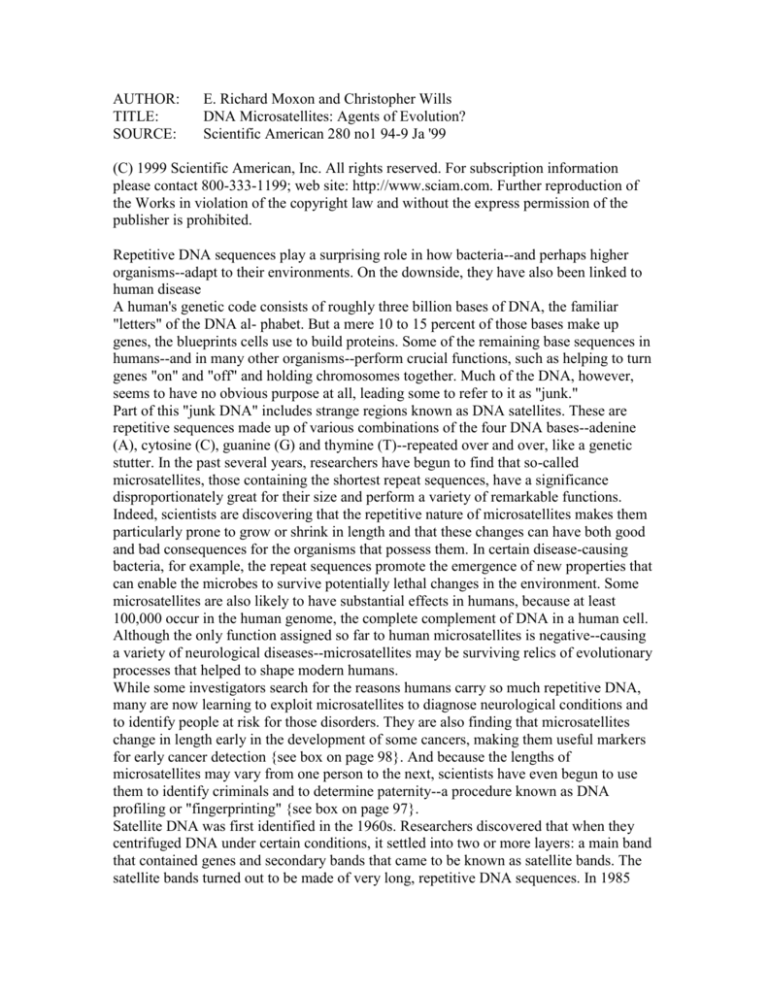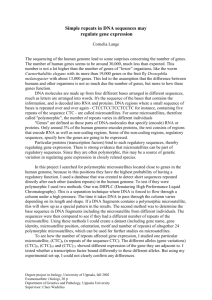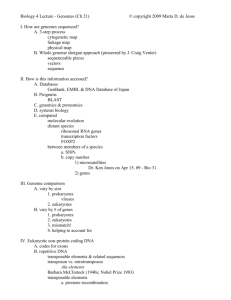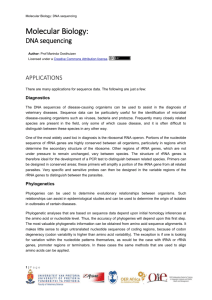
AUTHOR:
TITLE:
SOURCE:
E. Richard Moxon and Christopher Wills
DNA Microsatellites: Agents of Evolution?
Scientific American 280 no1 94-9 Ja '99
(C) 1999 Scientific American, Inc. All rights reserved. For subscription information
please contact 800-333-1199; web site: http://www.sciam.com. Further reproduction of
the Works in violation of the copyright law and without the express permission of the
publisher is prohibited.
Repetitive DNA sequences play a surprising role in how bacteria--and perhaps higher
organisms--adapt to their environments. On the downside, they have also been linked to
human disease
A human's genetic code consists of roughly three billion bases of DNA, the familiar
"letters" of the DNA al- phabet. But a mere 10 to 15 percent of those bases make up
genes, the blueprints cells use to build proteins. Some of the remaining base sequences in
humans--and in many other organisms--perform crucial functions, such as helping to turn
genes "on" and "off" and holding chromosomes together. Much of the DNA, however,
seems to have no obvious purpose at all, leading some to refer to it as "junk."
Part of this "junk DNA" includes strange regions known as DNA satellites. These are
repetitive sequences made up of various combinations of the four DNA bases--adenine
(A), cytosine (C), guanine (G) and thymine (T)--repeated over and over, like a genetic
stutter. In the past several years, researchers have begun to find that so-called
microsatellites, those containing the shortest repeat sequences, have a significance
disproportionately great for their size and perform a variety of remarkable functions.
Indeed, scientists are discovering that the repetitive nature of microsatellites makes them
particularly prone to grow or shrink in length and that these changes can have both good
and bad consequences for the organisms that possess them. In certain disease-causing
bacteria, for example, the repeat sequences promote the emergence of new properties that
can enable the microbes to survive potentially lethal changes in the environment. Some
microsatellites are also likely to have substantial effects in humans, because at least
100,000 occur in the human genome, the complete complement of DNA in a human cell.
Although the only function assigned so far to human microsatellites is negative--causing
a variety of neurological diseases--microsatellites may be surviving relics of evolutionary
processes that helped to shape modern humans.
While some investigators search for the reasons humans carry so much repetitive DNA,
many are now learning to exploit microsatellites to diagnose neurological conditions and
to identify people at risk for those disorders. They are also finding that microsatellites
change in length early in the development of some cancers, making them useful markers
for early cancer detection {see box on page 98}. And because the lengths of
microsatellites may vary from one person to the next, scientists have even begun to use
them to identify criminals and to determine paternity--a procedure known as DNA
profiling or "fingerprinting" {see box on page 97}.
Satellite DNA was first identified in the 1960s. Researchers discovered that when they
centrifuged DNA under certain conditions, it settled into two or more layers: a main band
that contained genes and secondary bands that came to be known as satellite bands. The
satellite bands turned out to be made of very long, repetitive DNA sequences. In 1985
Alec J. Jeffreys of the University of Leicester found other, shorter repetitive regions of
DNA, which he dubbed minisatellites, that turned out to consist of repeats of 15 or more
bases. (Jeffreys and his colleagues also determined that the number of repeats in a given
minisatellite differs between individuals, a finding that allowed them to invent the DNAfingerprinting technique.) In the late 1980s James L. Weber and Paula L. May of the
Marshfield Medical Research Foundation in Marshfield, Wis., and Michael Litt and
Jeffrey A. Luty of the Oregon Health Sciences University isolated satellites made up of
still shorter DNA repeats and named them microsatellites; these, too, would prove useful
for DNA fingerprinting.
Today scientists generally consider microsatellite DNA to consist of sequences of up to
six bases repeated over and over, end to end, like a train made up of the same type of
boxcar. What makes microsatellite DNA so important for evolution is its extremely high
mutation rate: it is 10,000 times more likely to gain or lose a repeat from one generation
to the next than a gene such as the one responsible for sickle cell anemia is to undergo the
single-base mutation leading to that disease. And although it is quite rare for the singlebase mutation that underlies sickle cell anemia to mutate back again to its benign state,
microsatellites can readily return to their former lengths, often within a few generations.
"Smart" Microbes
The role of microsatellites in the diversity of pathogenic bacteria was uncovered in 1986
in the laboratory of Thomas F. Meyer of the Max Planck Institute for Biology in
Tübingen. Meyer and his colleagues were studying Neisseria gonorrhoeae, the bacterium
that causes the sexually transmitted disease gonorrhea. N. gonorrhoeae, a single-celled
organism, possesses a family of up to 12 outer-membrane proteins that are encoded by
genes called Opas. (The name of the genes is derived from the opaque appearance of
bacterial colonies that make Opa proteins.) The proteins produced by the Opas are
important because they allow the bacterium to adhere to and to invade epithelial cells,
such as those that line the respiratory tract, as well as cells of the immune system called
phagocytes. Each of the Opa genes contains a microsatellite composed of multiple copies
of the five-base motif CTCTT.
The enormous variation conveyed by microsatellite repeats results from the fact that the
repeats are especially prone to DNA-replication errors, often through what is called
slipped-strand mispairing. Before a cell--bacterial or otherwise--can replicate, it must
make a duplicate set of its DNA. This is a complicated process because each DNA
molecule is a double helix resembling a twisted ladder, where the rungs of the ladder are
base pairs. The genetic code is spelled out by the bases on one side of the ladder; the
bases along the other side are complementary (A always pairs with T, and C with G).
During DNA replication, the ladder splits down the middle, separating the base pairs, as
enzymes called DNA polymerases copy each strand {see box on next page}. As the new
strand is made, it pairs with its template. Slipped-strand mispairing can occur when either
the old, template strand or the newly forming, complementary strand slips and pairs with
the wrong repeat on the other strand. This slippage causes the DNA polymerase to add or
delete one or more copies of the repeat in the new strand of DNA.
The frequency of such slippage mechanisms is very high in N. gonorrhoeae: each time
the bacteria divide, approximately one out of every 100 to 1,000 daughter cells will carry
a mutation that changes the number of CTCTT repeats. This change can have a dramatic
effect on the Opa genes, because genetic information is read in "words" of three bases,
called codons. Proteins are strings of amino acids, and each codon specifies a particular
amino acid in the protein chain. Because the repeat is not three bases long, an increase or
decrease in the number of repeats shifts the meaning of all the subsequent codons.
In the case of the Opa genes, deleting a CTCTT repeat leads to the production of a
protein that is shortened and cannot adhere to host cells; in consequence, the bacterium
bearing the shortened protein becomes unable to enter those cells. But subsequent
slippage has a good chance of adding the repeat back, thereby allowing the Opa gene to
produce a functional protein once again.
This reversible switching, called phase variation, has been found in many disease-causing
bacteria. By switching its various Opa genes on and off from one generation to the next,
N. gonorrhoeae can increase its chances for survival. There are times, for instance, when
it is useful for the microbe to stick to and enter host cells, such as when the bacterium is
spreading to a new host. At other times, it is strategically more advantageous for the
bacterium not to interact with host cells--particularly phagocytic cells, which engulf and
destroy bacteria.
The implications of slipped-strand mispairing for the ability of a bacterium to vary its
surface molecules have also been studied extensively in Hemophilus influenzae. Type b
strains of this bacterium are a primary cause of the life-threatening brain infection
bacterial meningitis. Until the advent of a vaccine in the late 1980s, roughly one in every
750 children younger than five years of age contracted H. influenzae meningitis.
The outer membrane of H. influenzae is studded with molecules of fats and sugars joined
together to make a molecule called lipopolysaccharide (LPS). One part of LPS, called
choline phosphate, helps H. influenzae stick to cells in the human nose and throat, where
the bacterium normally lives without eliciting symptoms. At least three of the genes
required for making LPS contain microsatellites built from the four-base sequence
CAAT. As is true of the microsatellites of the Opa genes of N. gonorrhoeae, changes in
the number of CAAT repeats in these genes can cause H. influenzae to make LPS that
either has or lacks choline phosphate.
Jeffrey N. Weiser of the University of Pennsylvania has shown that strains of H.
influenzae that have choline phosphates on their LPS molecules--so-called ChoP+
strains--colonize the human nose and throat more efficiently than strains without them,
which are referred to as ChoP- strains. Without ChoP, however, the bacterium is more
resistant to being killed by various factors present in the host's blood and in other tissue
fluids. The bacterial cells can switch between the two states, depending on whether they
are being left undisturbed to grow in the respiratory tract or are spreading through the
blood to other sites, where they are likely to be attacked by components of the immune
system.
Most H. influenzae bacteria isolated from humans are ChoP+ variants, which are
susceptible to the immune attack. ChoP- variants inevitably arise through slipped-strand
mispairing, but they usually do not persist in the respiratory tract, because they adhere
less efficiently to host cells than ChoP+ strains. But if the host contracts a viral infection
that inflames the nasal tissues, the inflammation can increase the exposure of the bacteria
to defense proteins of the host's immune system. In that case, ChoP- variants would have
an advantage because they can fend off such an attack. Once the viral infection subsides,
ChoP+ mutants generated by further slipped-strand mispairing of microsatellite DNA
will once again predominate.
Genes such as these that can switch on or off readily have been named contingency genes
for their ability to enable at least a few bacteria in a given population to adapt to new
environmental contingencies. The variety of traits encoded by contingency genes
includes those governing recognition by the immune system, general motility, movement
toward chemical cues (chemotaxis), attachment to and invasion of host cells, acquisition
of nutrients and sensitivity to antibiotics. Contingency genes make up a very small
fraction of a bacterium's DNA, but they can provide a vast amount of flexibility in
functioning. If only 10 of the 2,000 genes in a typical bacterium were contingency genes,
for instance, the bacterium would be able to display 210--1,024--different combinations
of "on" and "off" genes. Such diversity ensures that at least one bacterium in a population
can survive its host's immune or other defenses and then can replicate to produce a new,
thriving colony.
Causing disease--which can backfire by killing the life-giving host--may be one of the
prices that bacteria pay for their ability to produce so many variants. The occasional
variant may stray beyond its usual ecological niche in the host. It may penetrate the cells
lining the respiratory or intestinal tracts, for example, to yield a potentially fatal infection
elsewhere in the body. Provided that such events occur rarely, however, the benefits of
contingency genes for the survival of a bacterial species outweigh the disadvantages of
killing some hosts.
The microsatellites of these bacteria are true evolutionary adaptations. It is implausible
that such unusual repeats could have arisen by chance; they must have evolved and been
retained because they enable bacterial populations to adapt rapidly to environmental
changes.
Microsatellites in People
Useful as they are, contingency genes are apparently confined to bacteria. The role of
microsatellites seems to be very different in eukaryotic organisms like ourselves, whose
cells contain a nucleus. None of the eukaryotic microsatellites identified to date appear to
scramble the way DNA is read and to yield nonfunctional proteins. Most lie outside
genes, but roughly 10 percent actually fall within them. Of this 10 percent, almost all are
so-called triplet repeats, which tend to expand or contract in units of three bases. Just as
adding or deleting an "and" or a "the" in a sentence rarely obscures its meaning, triplet
repeats can expand or contract without disturbing a gene's message. Having the same
length as a codon, they may simply lead to insertion or removal of a few repetitive amino
acids without changing the sequence of all the others down the line.
So what are the functions of microsatellites in higher organisms? Scientists suspect that at
least some of them must have uses, because eukaryotes have more microsatellites than
bacteria and many of them happen to be in or near genes involved in pathways regulating
fundamental cellular processes. Only a few hints have yet emerged, however, about what
these purposes might be.
The few effects that have now been traced to eukaryotic microsatellites have generally
been harmful. For example, the grim neurodegenerative disorder Huntington's disease-characterized by late-onset dementia and gradual loss of motor control--is triggered by a
flawed version of a gene that codes for a large protein, huntingtin, of unknown function.
The normal gene contains a long, triplet-repeat microsatellite that adds a string of amino
acids called glutamines near the start of the protein.
The number of glutamines at the beginning of the huntingtin protein usually ranges from
10 to 30. But people who have--or who are destined to develop--Huntington's disease
carry a microsatellite coding for an unusually long run of 36 or more glutamines.
Inheritance of just one copy of the flawed gene, from the mother or the father, is enough
to ensure eventual illness. It is not yet clear how the long stretches of glutamines
contribute to Huntington's.
More than a dozen such triplet-repeat diseases are now known; most are rare neurological
diseases. About half the disease-causing microsatellite repeats are inside a gene, and most
encode glutamines. The rest are sufficiently close to nearby genes that they can affect
their function.
One of these rare neurological diseases--spinal bulbar muscular atrophy--results from
expansion of a microsatellite inside a gene on the X chromosome; the gene codes for a
receptor for the male hormone androgen. People with 40 or more triplet repeats in part of
one of their androgen receptor genes develop the disease. But a group led by E. L. Yong
of National University Hospital in Singapore has demonstrated that repeats that are even
slightly longer than normal can also have medical effects. They reported in 1997 that men
with between 28 and 40 repeats in the part of the androgen receptor gene that encodes
glutamines were likely to be infertile.
Too few triplet repeats in the androgen receptor can also have untoward consequences.
Several other research groups have shown that men with 23 or fewer repeats have an
increased risk of prostate cancer. Such cases are unusual, however.
Evolving Evolvability
Why do we have all these genetic time-bombs ticking inside our genomes? It is striking
that so many of our triplet-repeat diseases involve neurological function and that none of
those linked to triplet repeats in humans have yet been reported in other primates, such as
chimpanzees. If such diseases turn out to be unique to humankind, they might represent a
genetic cost we have incurred because of the rapid evolution of our brains. It is possible
that long microsatellites at or near certain genes might contribute to brain function and
might therefore have persisted throughout evolutionary time even though they
occasionally expand too much and cause disease.
In 1989 one of us (Wills) postulated on theoretical grounds that some genes have evolved
the ability to evolve. According to the hypothesis, in an environment that fluctuates in
some predictable way--such as growing warmer or cooler--possessing the genetic
apparatus to evolve quickly would have advantages. The contingency genes of bacteria
have turned out to be excellent examples of evolvability genes: their high rates of forward
and backward mutation allow bacteria to adapt rapidly to predictable environmental
changes and then to revert back again when the earlier conditions reappear.
Perhaps eukaryotic microsatellites exert a more subtle form of regulation than that
provided by bacterial contingency genes. In humans, microsatellites within genes have
been found that influence the production rate of a number of proteins, ranging from the
bile pigment bilirubin to neurotransmitters, the chemicals that carry messages between
nerve cells. David G. King of Southern Illinois University has suggested that such
microsatellites may be "tuning knobs" that evolved to act as rheostats for gene function,
turning up the amount of protein produced by a gene in some instances and decreasing it
in others.
Indeed, Walter Schaffner and his colleagues at the University of Zurich have shown that
adding microsatellites that encode runs of glutamines or prolines (another amino acid) at
the start of a known gene can increase its ability to yield protein. Perhaps, because it is so
much less disruptive than contingency gene switching, this form of gene regulation
emerged during the evolution of complex, multicellular organisms.
Scientists have only begun to probe the roles of microsatellites in our own species. It may
be that the repeats, with their ability to switch rapidly among a limited number of states,
will provide insights into our own capacity to adapt to environmental change, just as
contingency genes have done in bacteria.
Added material
MICROSATELLITE (highlighted region) in this example consists of a specific sequence
of DNA units, or bases--CAAT (cytosine-adenine-adenine-thymine)--repeated five times;
each CAAT sequence is always paired with a complementary GTTA (guanine-thyminethymine-adenine) sequence on the opposite strand of the DNA "ladder." The repeating
sequences, or motifs, in microsatellites can contain up to six bases, and each sequence
can be present in multiple copies. (TOMO NARASHIMA)
Slipped-Strand Mispairing
In this process, the number of microsatellite repeats increases or shrinks when a cell
copies its DNA before dividing. During DNA replication (a), enzymes called the DNA
polymerase complex unzip the parental DNA helix and copy both strands. One of the
copies is made piecemeal: the polymerase complex synthesizes a short fragment (1)
beginning with an RNA primer, then skips ahead to generate a second short fragment (2).
When the polymerase finishes the second fragment, the RNA primer is removed, and the
two fragments are connected with DNA. Increases in the number of microsatellite repeats
(b) occur when the new strand slips down one repeat in its binding to the old, template
strand, causing the polymerase to add an extra repeat in the new strand to fill the gap.
Decreases (c) happen when the old strand slips, which results in repair enzymes deleting
a repeat. (TOMO NARASHIMA AND GEORGE RETSECK)
The Authors
E. RICHARD MOXON and CHRISTOPHER WILLS approach the study of DNA
microsatellites from two different vantage points. Moxon is a pediatrician and an
infectious disease specialist; Wills is an evolutionary biologist. Moxon currently heads
both the department of pediatrics at the University of Oxford and the Molecular
Infectious Diseases Group of the Institute of Molecular Medicine at John Radcliffe
Hospital in Oxford, England. Wills is a professor of biology at the University of
California, San Diego. He is the author of several popular books on evolutionary biology,
including Yellow Fever, Black Goddess (Addison-Wesley, 1996) and Children of
Prometheus: The Accelerating Pace of Human Evolution (Perseus Books, 1998).
Further Reading
Adaptive Evolution of Highly Mutable Loci in Pathogenic Bacteria. E. R. Moxon et al. in
Current Biology, Vol. 4, No. 1, pages 24-33; January 1, 1994.
Evolutionary Tuning Knobs. D. G. King, M. Soller and Y. Kashi in Endeavour, Vol. 21,
No. 1, pages 36-40; 1997.
Furtive Mating in Female Chimpanzees. P. Gagneux, D. S. Woodruff and C. Boesch in
Nature, Vol. 387, pages 358-359; May 22, 1997.









